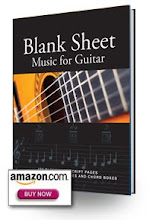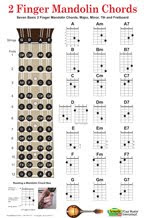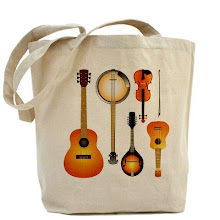We are pleased to announce the release of our new 2nd edition of Essential Chords for Guitar, Mandolin, Ukulele and Banjo. Lots of changes and updates, new size, 4 and 5 string banjo chords, and we also have an iPad version.
Book Description
Essential Chords for Guitar, Mandolin, Ukulele and Banjo, Second Edition is an updated version of the original popular chord chart book for the beginning music player. Essential Chords contains fingering charts for guitar, mandolin, ukulele and banjo chords and a variety of other music charts for playing rock, folk, country and blues music. Now in a new, larger size, updated and with new 4 and 5 string banjo tunings, this is the perfect resource for every player.
Simple, clean, easy to read fingering charts for all players showing the 7 basic Guitar, Mandolin, Ukulele and Banjo chords, A-G for Major, Minor and 7th chords. Includes the I, IV, V chord progressions for each key. Plus movable Guitar fingerings for barre chords, arpeggio scales, and soloing scales for folk, country, rock and blues, and movable Mandolin arpeggio scales. The charts are designed to be easy to read and follow.
Essential Chords includes blank sheet music and chord box pages for each instrument that you can photocopy. Each sheet music page has the lines spread apart for ease in writing down your music.
Chord and Music Charts in the Book
• The Seven Basic Guitar Chords, Major, Minor and 7th
• The Seven Guitar Keys with I, IV, V and V7 Chords
• Guitar Barre Chords
• Major Movable Soloing Scale for Folk or Country Music for Any Key
• Minor Pentatonic Movable Soloing Scale for Blues, Rock or Latin Music
• Movable Arpeggio Scale for Any Guitar Key
• Guitar Power Chords
• Diminished Guitar Chords
• Augmented Guitar Chords
• Sus2 and Sus4 Guitar Chords
• Mandolin Chords, Major, Minor and 7th
• Mandolin Two Finger Chords
• The Seven Mandolin Keys with the I, IV, V and V7 Chords
• 2 Finger Mandolin Chords for a I, IV, V Progression
• Movable Arpeggio Scale for Any Mandolin Key
• Ukulele Chords, Major, Minor and 7th
• The Seven Ukulele Keys with the I, IV, V and V7 Chords in First Position
• Banjo Chords, 5 String, A, C, Double C, D and G Tunings Major, Minor and 7th
• Banjo Chords, 4 String, Standard, Celtic/Irish and Chicago Tunings, Major, Minor and 7th
• Blank Guitar, Mandolin, Ukulele and Banjo Sheet Music and Chord Boxes
Available at Amazon.com
Tuesday, November 22, 2011
Tuesday, November 1, 2011
Vamping and Getting Different Sounds on Your Guitar
We received this question today here at Acoustic Music TV:
I have a question ---- is there a way you can show how chord progression applies to vamping for playing back up chords to songs in different keys and maybe give examples or explain how this would work?
As I play the banjo.
Answer
HI, and thank you for your question. I know a little but not that much on vamping. What I tend to do is to find the same chord in a different place on the guitar or mandolin and play that, which are the instruments I play the most, I also use the relative minor chords, those work pretty well also for a different sound. To play relative minor chords you play the chord that is 3 half steps down from the root of any major chord, this is the relative minor. So for G play Em, think G, F, Em, for C it is Am etc. This is sort of chord substitution but you get the idea. You can mix all this stuff together to create progressions and new sounds.
I also tend to sometimes play the opposite chord to the key that is being played. So if everyone is jamming and playing the G chord part of the song I might play the D chord in the Key of G or the C. This doesn't really work if we are playing the song in order with all the correct chords but does work if we just start jamming on the song, like if you are playing the verse over and over again and people are just trying different things. I switch it up, throw in a different chord in that key.
The other thing I do is play the movable arpeggios scale for the key. I just play little made up patterns. Once you know the scale then you can play any of those notes and it will sound correct. Great for making up a quick solo that isn't the melody of the song and it sounds correct. I have those charts in the Essential Chords for the guitar and mandolin but never made one for the banjo. I should work on that. You might be able to figure out what they are for the tuning you are working in.
Another thing I do is play a lower sounding version of the chord for the verse and then a higher sounding version of the chord for the chorus or to just throw in a different sound. Lets take a G chord, normally I would play it in the 1st position and it would sound fine, but I could also play it up on the 7th fret on the top three strings. It has a much higher sound but it is still a G chord.
hope this helps, great question
I have a question ---- is there a way you can show how chord progression applies to vamping for playing back up chords to songs in different keys and maybe give examples or explain how this would work?
As I play the banjo.
Answer
HI, and thank you for your question. I know a little but not that much on vamping. What I tend to do is to find the same chord in a different place on the guitar or mandolin and play that, which are the instruments I play the most, I also use the relative minor chords, those work pretty well also for a different sound. To play relative minor chords you play the chord that is 3 half steps down from the root of any major chord, this is the relative minor. So for G play Em, think G, F, Em, for C it is Am etc. This is sort of chord substitution but you get the idea. You can mix all this stuff together to create progressions and new sounds.
I also tend to sometimes play the opposite chord to the key that is being played. So if everyone is jamming and playing the G chord part of the song I might play the D chord in the Key of G or the C. This doesn't really work if we are playing the song in order with all the correct chords but does work if we just start jamming on the song, like if you are playing the verse over and over again and people are just trying different things. I switch it up, throw in a different chord in that key.
The other thing I do is play the movable arpeggios scale for the key. I just play little made up patterns. Once you know the scale then you can play any of those notes and it will sound correct. Great for making up a quick solo that isn't the melody of the song and it sounds correct. I have those charts in the Essential Chords for the guitar and mandolin but never made one for the banjo. I should work on that. You might be able to figure out what they are for the tuning you are working in.
Another thing I do is play a lower sounding version of the chord for the verse and then a higher sounding version of the chord for the chorus or to just throw in a different sound. Lets take a G chord, normally I would play it in the 1st position and it would sound fine, but I could also play it up on the 7th fret on the top three strings. It has a much higher sound but it is still a G chord.
hope this helps, great question
Labels:
arpeggio,
Chord Charts,
guitar chord charts,
J. Bruce Jones
Subscribe to:
Posts (Atom)










